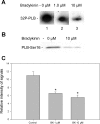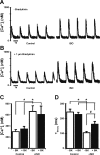Novel bradykinin signaling in adult rat cardiac myocytes through activation of p21-activated kinase
- PMID: 20154261
- PMCID: PMC2853422
- DOI: 10.1152/ajpheart.01070.2009
Novel bradykinin signaling in adult rat cardiac myocytes through activation of p21-activated kinase
Abstract
Although bradykinin (BK) is known to exert effects on the myocardium, its intracellular signaling pathways remain poorly understood. Experiments in other cell types indicated that p21-activated kinase-1 (Pak1), a Ser/Thr kinase downstream of small monomeric G proteins, is activated by BK. We previously reported that the expression of active Pak1 in adult cardiac myocytes induced activation of protein phosphatase 2A and dephosphorylation of myofilament proteins (Ke et al. Circ Res 94: 194-200, 2004). In experiments reported here, we tested the hypothesis that BK signals altered protein phosphorylation in adult rat cardiac myocytes through the activation and translocation of Pak1. Treatment of myocytes with BK resulted in the activation of Pak1 as demonstrated by increased autophosphorylation at Thr423 and a diminished striated localization, which is present in the basal state. BK induced dephosphorylation of both cardiac troponin I and phospholamban. Treatment of isolated myocytes with BK also blunted the effect of isoproterenol to enhance peak Ca(2+) and relaxation of Ca(2+) transients. Protein phosphatase 2A was demonstrated to associate with both Pak 1 and phospholamban. Our studies indicate a novel signaling mechanism for BK in adult rat cardiac myocytes and support our hypothesis that Pak 1 is a significant regulator of phosphatase activity in the heart.
Figures






Similar articles
-
Expression of active p21-activated kinase-1 induces Ca2+ flux modification with altered regulatory protein phosphorylation in cardiac myocytes.Am J Physiol Cell Physiol. 2009 Jan;296(1):C47-58. doi: 10.1152/ajpcell.00012.2008. Epub 2008 Oct 15. Am J Physiol Cell Physiol. 2009. PMID: 18923061 Free PMC article.
-
Protein kinase D selectively targets cardiac troponin I and regulates myofilament Ca2+ sensitivity in ventricular myocytes.Circ Res. 2007 Mar 30;100(6):864-73. doi: 10.1161/01.RES.0000260809.15393.fa. Epub 2007 Feb 22. Circ Res. 2007. PMID: 17322173
-
Cardiac function is regulated by B56α-mediated targeting of protein phosphatase 2A (PP2A) to contractile relevant substrates.J Biol Chem. 2014 Dec 5;289(49):33862-73. doi: 10.1074/jbc.M114.598938. Epub 2014 Oct 15. J Biol Chem. 2014. PMID: 25320082 Free PMC article.
-
Regulation of phospholamban and troponin-I phosphorylation in the intact rat cardiomyocytes by adrenergic and cholinergic stimuli: roles of cyclic nucleotides, calcium, protein kinases and phosphatases and depolarization.Mol Cell Biochem. 1995 Aug-Sep;149-150:103-26. doi: 10.1007/BF01076569. Mol Cell Biochem. 1995. PMID: 8569720 Review.
-
p21-Activated kinase-1 and its role in integrated regulation of cardiac contractility.Am J Physiol Regul Integr Comp Physiol. 2007 Sep;293(3):R963-73. doi: 10.1152/ajpregu.00253.2007. Epub 2007 Jul 3. Am J Physiol Regul Integr Comp Physiol. 2007. PMID: 17609315 Review.
Cited by
-
Functional integrity of the T-tubular system in cardiomyocytes depends on p21-activated kinase 1.J Mol Cell Cardiol. 2013 Jul;60:121-8. doi: 10.1016/j.yjmcc.2013.04.014. Epub 2013 Apr 20. J Mol Cell Cardiol. 2013. PMID: 23612118 Free PMC article.
-
The curious role of sarcomeric proteins in control of diverse processes in cardiac myocytes.J Gen Physiol. 2010 Jul;136(1):13-9. doi: 10.1085/jgp.201010462. J Gen Physiol. 2010. PMID: 20584888 Free PMC article. No abstract available.
-
Cardioprotection in ischemia/reperfusion injury: spotlight on sphingosine-1-phosphate and bradykinin signalling.Prog Biophys Mol Biol. 2010 Sep;103(1):142-7. doi: 10.1016/j.pbiomolbio.2010.01.001. Epub 2010 Jan 18. Prog Biophys Mol Biol. 2010. PMID: 20080123 Free PMC article. Review.
-
Novel roles of PAK1 in the heart.Cell Logist. 2012 Apr 1;2(2):89-94. doi: 10.4161/cl.21497. Cell Logist. 2012. PMID: 23162741 Free PMC article.
-
Targeting p21-activated kinase 1 for development of a novel anti-arrhythmic drug class.Philos Trans R Soc Lond B Biol Sci. 2023 Jun 19;378(1879):20220285. doi: 10.1098/rstb.2022.0285. Epub 2023 May 1. Philos Trans R Soc Lond B Biol Sci. 2023. PMID: 37122206 Free PMC article. Review.
References
-
- Arteaga GM, Warren CM, Milutinovic S, Martin AF, Solaro RJ. Specific enhancement of sarcomeric response to Ca2+ protects murine myocardium against ischemia-reperfusion dysfunction. Am J Physiol Heart Circ Physiol 289: H2183–H2192, 2005 - PubMed
-
- Barr E, Carroll J, Kalynych AM, Tripathy SK, Kozarsky K, Wilson JM, Leiden JM. Efficient catheter-mediated gene transfer into the heart using replication-defective adenovirus. Gene Ther 1: 51–58, 1994 - PubMed
-
- Chen J, Parsons S, Brautigan DL. Tyrosine phosphorylation of protein phosphatase 2A in response to growth stimulation and v-src transformation of fibroblasts. J Biol Chem 269: 7957–7962, 1994 - PubMed
Publication types
MeSH terms
Substances
Grants and funding
LinkOut - more resources
Full Text Sources
Research Materials
Miscellaneous

